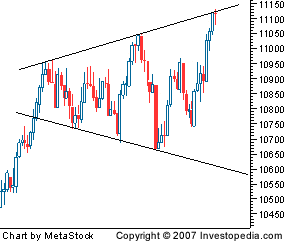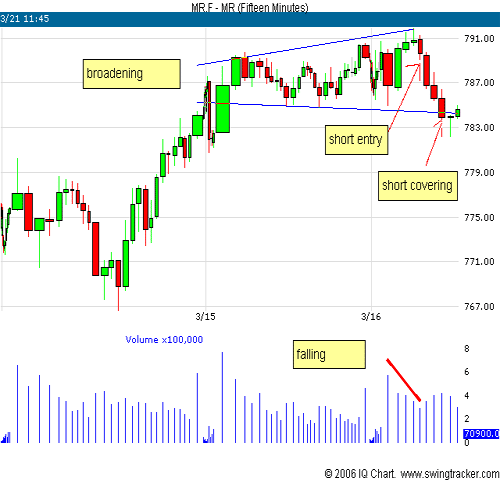Trade Recap
The chart below shows an example of the broadening formation, considered normally to be a bearish formation. These patterns don't form very frequently and they normally are considered to be an early sign of a market top. This formation begins with the price action diverging wider toward the right as volume increases. Traders will watch for a move off the upper resistance and for a corrective move toward the lower support. A change in the uptrend is confirmed when the price breaks below the lower trendline. This formation is formed by a very emotional crowd and a higher-than-normal participation from the general public, making it a difficult pattern to identify and trade.
 |
| Figure 1: A broadening pattern |
In Figure 1, two trendlines are drawn but they are moving away from each other. This shape is the mirror-image of the triangle except it's diverging instead of converging. The trendlines are taken from two pivot highs and two pivot lows. Once identified, the best possible trade setup is to short the third pivot (rightmost test of the resistance shown by the doji star) at the top trendline for an aggressive trader, or to short after prices have broken down from the bottom trendline for a more conservative trader. (For related reading, see Triangles: A Short Study In Continuation Patterns.)
The Setup
On Friday, March 16, 2007, prices were locked in a 785 and 792 range on the E-mini Russell 2000 chart, moving up and down with each pivot high and pivot low widening (moving away from each other in distance). At the start of the pattern, it seemed like a continuation pattern was at work, ready to break to the upside again. However, the 792 level was a special resistance due to the fact that it was a major retracement level on the 60-minute chart. (For more insight, see Continuation Patters - Part 1, Part 2, Part 3 and Part 4.)
After a series of pivot highs and pivot lows, the price closed near the trendline following the third bounce and the broadening pattern was identified. When it finally made the new high, it was quickly rejected. For many traders, this break into the new high represented a signal to go long. It only became evident it was a bull trap in the following bar. If it weren't for the volume showing low buying to signal a false breakout, the pattern would have been broken.
Figure 2 shows how a new high (the bar with the red arrow) was made on falling volume. The following bar, the down bar, was immediately seen, indicating that there were not enough buyers to push it higher. It fell on its own weight.
 |
| Figure 2 |
The short entry was taken at the break of the low of the previous bar (one with red arrow). The target was the lower trendline, 784.
As the momentum carried down the prices to meet the bottom trendline, volume increased - a sign that the market players were comfortable trading inside the formation and didn't want a breakout. When the price finally arrived at the target, many traders started to cover their short positions immediately.
 |
| Figure 3 |
When price met at the lower range support, volume again dropped, showing no interest in taking the prices lower. The reversal was made with a hammer candle, which is represented by a red arrow in Figure 3.
|
A Reversal?
It would have looked like a reversal of the uptrend was underway when the price fell below the lower trendline, but the reversal stopped short and made a pullback toward the lower trendline. This is often a problem when trading a broadening formation because it can often look like an impending breakout to the downside as prices move below the support but, as you can see in Figure 4, the selling pressure doesn't always increase when the bottom trendline is broken. (To read more about reversals, check out Market Reversals And How To Spot Them.)
 |
| Figure 4 |
Conclusion
Broadening patterns can be profitable, but it is important to realize how tricky they can be. In a broadening pattern, the price often looks like it is breaking but instead, it reverses back into the formation. For trend-following traders, our example was a frustrating pattern to handle. For the range traders, it was home. The clear indicator that the formation was likely to continue was the volume weakness when it reached either extreme of the pattern. Figure out the pattern first and let both price and volume confirm it. Volume leads price and volume is the major component in confirming the pattern when the price shows ambiguity.
By Larry Swing
Larry Swing is the President of the popular day and swing trading site, www.mrswing.com. MrSwing.com is a place where you can find free daily articles and videos covering education, market analysis and picks from Larry, his professional team and other well known traders in the industry. In addition to this, you'll also find an active forum where you can interact with and learn from experienced traders.
No comments:
Post a Comment